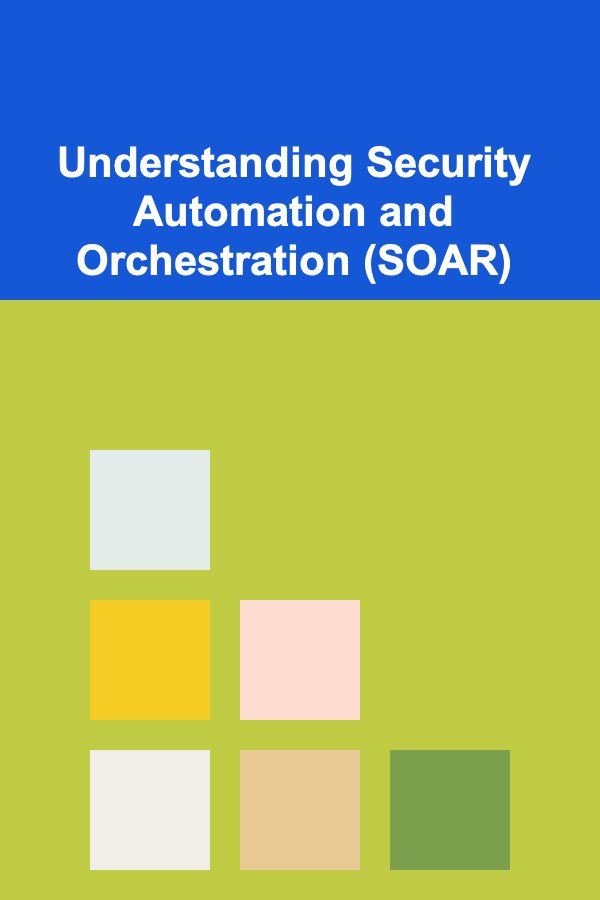
Understanding Security Automation and Orchestration (SOAR)
ebook include PDF & Audio bundle (Micro Guide)
$12.99$10.99
Limited Time Offer! Order within the next:

In today's complex and rapidly evolving cybersecurity landscape, organizations face a daunting challenge: defending against an ever-increasing volume of sophisticated threats while simultaneously grappling with a shortage of skilled security professionals. Security Automation and Orchestration (SOAR) has emerged as a critical solution to this challenge, offering the ability to streamline security operations, improve incident response, and enhance overall security posture.
What is SOAR?
SOAR stands for Security Automation, Orchestration, and Response. It represents a collection of technologies that allow organizations to collect security data from various sources, analyze it, and automate responses to security incidents and vulnerabilities. SOAR platforms combine automation capabilities with orchestration workflows and incident management features to enable faster, more efficient, and more consistent security operations.
To break it down further:
- Security Automation: Involves using technology to automatically execute repetitive or time-consuming security tasks. This can include things like threat intelligence enrichment, vulnerability scanning, and log analysis. Automation frees up security analysts from manual tasks, allowing them to focus on more complex and strategic activities.
- Security Orchestration: Focuses on coordinating and integrating different security tools and processes into a unified workflow. This involves connecting various security technologies, such as firewalls, intrusion detection systems (IDS), endpoint detection and response (EDR) solutions, and threat intelligence platforms (TIPs), to enable them to work together seamlessly.
- Security Response: Encompasses the actions taken to address security incidents. SOAR helps automate and streamline incident response processes, enabling faster containment, eradication, and recovery from security breaches. This includes triggering automated alerts, isolating infected systems, and implementing remediation actions.
The Need for SOAR
The growing complexity of the threat landscape and the increasing demands on security teams have made SOAR a necessity for many organizations. Here's why:
1. Increasing Alert Volume and Complexity
Security teams are bombarded with alerts from numerous security tools. Many of these alerts are false positives, requiring analysts to spend significant time investigating and triaging. SOAR helps filter out noise, prioritize alerts based on risk, and provide context to analysts, enabling them to focus on the most critical threats.
2. Shortage of Skilled Security Professionals
The cybersecurity skills gap is a persistent challenge. There are simply not enough qualified security professionals to fill all the open positions. SOAR helps address this gap by automating tasks that would otherwise require manual effort, allowing existing security teams to be more productive and efficient.
3. Inefficient Incident Response Processes
Manual incident response processes are often slow, inconsistent, and error-prone. SOAR automates and orchestrates incident response workflows, enabling faster containment, eradication, and recovery from security breaches. This reduces the impact of incidents and minimizes downtime.
4. Lack of Integration Between Security Tools
Security tools often operate in silos, making it difficult to correlate data and gain a holistic view of the security landscape. SOAR integrates disparate security tools, enabling them to share information and work together more effectively. This provides security teams with better visibility and control over their environment.
5. Evolving Threat Landscape
Cyber threats are constantly evolving, and organizations need to adapt quickly to stay ahead of attackers. SOAR helps organizations respond to new threats more quickly and effectively by automating threat intelligence enrichment, vulnerability scanning, and incident response processes.
Key Capabilities of a SOAR Platform
A robust SOAR platform typically includes the following capabilities:
1. Incident Management
SOAR platforms provide a centralized hub for managing security incidents, including:
- Incident Tracking: Logging and tracking all security incidents, including details such as the type of incident, affected systems, and assigned personnel.
- Incident Prioritization: Automatically prioritizing incidents based on severity, impact, and other factors.
- Incident Investigation: Providing analysts with the tools and information they need to investigate incidents, including threat intelligence data, system logs, and network traffic analysis.
- Incident Resolution: Guiding analysts through the process of resolving incidents, including containment, eradication, and recovery steps.
- Reporting and Analytics: Generating reports on incident trends, performance metrics, and other key indicators.
2. Threat Intelligence Platform (TIP) Integration
SOAR platforms integrate with TIPs to enrich security alerts with threat intelligence data, providing analysts with valuable context about potential threats. This integration enables:
- Automated Threat Intelligence Enrichment: Automatically enriching security alerts with information from TIPs, such as IP addresses, domain names, and malware hashes.
- Threat Hunting: Using threat intelligence data to proactively search for threats in the environment.
- Blocking Malicious Indicators: Automatically blocking malicious IP addresses, domain names, and other indicators of compromise.
3. Workflow Automation and Orchestration
SOAR platforms allow organizations to create and automate complex security workflows, orchestrating actions across multiple security tools. This includes:
- Playbook Creation: Defining automated workflows for responding to specific types of security incidents. These playbooks can include steps such as isolating infected systems, blocking malicious traffic, and notifying stakeholders.
- Integration with Security Tools: Connecting various security tools, such as firewalls, IDS/IPS, EDR, and SIEM, to enable them to work together seamlessly.
- Automated Task Execution: Automatically executing tasks within a workflow, such as running scripts, sending emails, and updating security policies.
4. Case Management
Similar to Incident Management, Case Management is particularly useful for more complex, multi-stage investigations that may span longer periods. This functionality allows for:
- Centralized Case Repository: A single location to store all related information and artifacts for a particular security investigation, including alerts, logs, reports, and analyst notes.
- Collaboration and Communication: Enables security teams to collaborate and communicate effectively on investigations, sharing information and updates in real-time.
- Auditing and Reporting: Provides a comprehensive audit trail of all actions taken during an investigation, which is useful for compliance and reporting purposes.
5. Reporting and Analytics
SOAR platforms offer robust reporting and analytics capabilities, enabling organizations to track key security metrics and identify areas for improvement. This includes:
- Incident Response Metrics: Tracking metrics such as mean time to detect (MTTD), mean time to respond (MTTR), and the number of incidents resolved.
- Workflow Performance Metrics: Measuring the efficiency of automated workflows, such as the time it takes to complete specific tasks.
- Security Posture Analysis: Identifying vulnerabilities and weaknesses in the security environment.
How SOAR Works: A Simplified Workflow
Imagine a scenario where a suspicious file is detected on a user's endpoint. Here's how SOAR might automate and orchestrate the response:
- Alert Generation: The endpoint detection and response (EDR) solution detects the suspicious file and generates an alert.
- SOAR Ingestion: The SOAR platform ingests the alert from the EDR system.
- Threat Intelligence Enrichment: The SOAR platform automatically enriches the alert with threat intelligence data from a TIP. This data might include information about the file's reputation, associated malware families, and known attack campaigns.
- Analysis and Triage: Based on the threat intelligence data and predefined rules, the SOAR platform automatically prioritizes the alert. If the file is deemed highly suspicious, the platform might trigger a predefined playbook.
- Playbook Execution: The playbook executes a series of automated actions:
- Isolation: The playbook instructs the EDR solution to isolate the affected endpoint from the network to prevent further spread of the potential threat.
- Scanning: The playbook triggers a full scan of the endpoint to identify any other potentially infected files or processes.
- Reporting: The playbook sends an alert to the security analyst, providing them with all the relevant information about the incident.
- Ticketing: The playbook automatically creates a ticket in the organization's ticketing system, assigning it to the security analyst for further investigation.
- Analyst Investigation: The security analyst reviews the information provided by the SOAR platform and takes any necessary additional actions, such as further investigation of the file or remediation of the endpoint.
- Resolution: Once the incident is resolved, the security analyst closes the ticket in the ticketing system.
- Reporting: The SOAR platform automatically generates a report on the incident, tracking key metrics such as the time it took to detect and respond to the threat.
This simplified example illustrates how SOAR can automate and orchestrate security processes, freeing up security analysts to focus on more complex and strategic tasks.
Benefits of Implementing SOAR
Implementing a SOAR platform can provide a wide range of benefits to organizations, including:
1. Improved Efficiency and Productivity
SOAR automates repetitive tasks, freeing up security analysts to focus on more complex and strategic activities. This improves efficiency and productivity, allowing security teams to handle a higher volume of alerts and incidents with fewer resources.
2. Faster Incident Response
SOAR automates and orchestrates incident response processes, enabling faster containment, eradication, and recovery from security breaches. This reduces the impact of incidents and minimizes downtime.
3. Enhanced Threat Visibility
SOAR integrates disparate security tools, providing security teams with a more holistic view of the security landscape. This improves threat visibility and enables faster detection of malicious activity.
4. Reduced Alert Fatigue
SOAR filters out false positives and prioritizes alerts based on risk, reducing alert fatigue and enabling analysts to focus on the most critical threats.
5. Improved Compliance
SOAR provides a comprehensive audit trail of all security activities, which is useful for compliance and reporting purposes.
6. Better Security Posture
By automating and orchestrating security processes, SOAR helps organizations improve their overall security posture and reduce their risk of being compromised.
Challenges of Implementing SOAR
While SOAR offers significant benefits, it's important to be aware of the challenges associated with implementing and maintaining a SOAR platform:
1. Initial Investment and Integration Costs
Implementing a SOAR platform can require a significant upfront investment, including the cost of the software license, hardware, and integration services. Integrating SOAR with existing security tools can also be a complex and time-consuming process.
2. Complexity and Customization
SOAR platforms can be complex to configure and customize, requiring specialized skills and expertise. Organizations need to develop custom playbooks and integrations to meet their specific security requirements.
3. Data Quality and Integrity
The effectiveness of SOAR depends on the quality and integrity of the data that it receives from various security tools. If the data is inaccurate or incomplete, the SOAR platform may make incorrect decisions.
4. Ongoing Maintenance and Updates
SOAR platforms require ongoing maintenance and updates to ensure that they are working properly and that they are up-to-date with the latest threats. Organizations need to dedicate resources to monitoring the performance of the SOAR platform and making necessary adjustments.
5. Skills Gap
Operating and maintaining a SOAR platform requires specialized skills and expertise, which can be difficult to find and retain. Organizations may need to invest in training and development to ensure that their security teams have the necessary skills.
SOAR vs. SIEM
It's important to understand the difference between SOAR and Security Information and Event Management (SIEM) systems, as they often work together but serve distinct purposes.
- SIEM: Focuses on collecting, analyzing, and correlating security logs and events from various sources to identify potential threats. SIEM systems are primarily used for threat detection, compliance monitoring, and security reporting.
- SOAR: Focuses on automating and orchestrating security responses to incidents and vulnerabilities. SOAR platforms use data from SIEM systems and other security tools to trigger automated workflows and take actions to contain and eradicate threats.
In essence, SIEM detects, and SOAR responds. A well-integrated SIEM and SOAR solution can provide a comprehensive security operations platform, enabling organizations to detect, analyze, and respond to threats more quickly and effectively.
SOAR Use Cases
SOAR can be applied to a wide range of security use cases, including:
- Phishing Incident Response: Automating the process of investigating and responding to phishing emails, including blocking malicious senders, removing malicious attachments, and resetting compromised user accounts.
- Malware Analysis and Response: Automating the analysis of malware samples and the response to malware infections, including isolating infected systems, removing malware, and restoring data.
- Vulnerability Management: Automating the process of identifying and remediating vulnerabilities, including scanning for vulnerabilities, prioritizing remediation efforts, and tracking remediation progress.
- Threat Hunting: Using threat intelligence data and automated workflows to proactively search for threats in the environment.
- Insider Threat Detection and Response: Monitoring user activity and automating the response to potential insider threats, such as data exfiltration and unauthorized access.
- Data Breach Response: Automating the response to data breaches, including containing the breach, notifying affected individuals, and complying with regulatory requirements.
- Security Orchestration for Cloud Environments: Automating security tasks and policies across multi-cloud and hybrid cloud environments.
Selecting a SOAR Platform
Choosing the right SOAR platform for your organization is crucial. Here are some factors to consider:
- Integration Capabilities: Ensure the platform integrates seamlessly with your existing security tools and technologies.
- Ease of Use: The platform should be easy to use and configure, with a user-friendly interface and intuitive workflow design tools.
- Scalability: The platform should be able to scale to meet the growing needs of your organization.
- Flexibility: The platform should be flexible enough to support a wide range of use cases and customization requirements.
- Reporting and Analytics: The platform should offer robust reporting and analytics capabilities to track key security metrics and identify areas for improvement.
- Vendor Support: Choose a vendor that provides excellent customer support and training.
- Cost: Consider the total cost of ownership, including the cost of the software license, hardware, integration services, and ongoing maintenance.
- Specific Use Case Requirements: Consider your specific security needs and choose a platform that is well-suited to address those needs. For example, if you are primarily concerned with phishing attacks, look for a platform that has strong phishing incident response capabilities.
Conclusion
Security Automation and Orchestration (SOAR) is a powerful technology that can help organizations streamline security operations, improve incident response, and enhance their overall security posture. By automating repetitive tasks, orchestrating security workflows, and integrating disparate security tools, SOAR enables security teams to be more efficient, productive, and effective. While implementing SOAR can be challenging, the benefits outweigh the risks for many organizations. As the threat landscape continues to evolve and the demands on security teams increase, SOAR will become an increasingly critical component of a comprehensive cybersecurity strategy.
Reading More From Our Other Websites
- [Sewing Tip 101] Custom Fit Secrets: Tailoring a Dress to Flatter Every Body Shape
- [Home Soundproofing 101] How to Soundproof a Bathroom for Privacy
- [Home Renovating 101] How to Renovate Your Basement and Add Extra Living Space
- [Home Holiday Decoration 101] How to Decorate with Holiday Bows to Add Festive Flair
- [Hiking with Kids Tip 101] Trail Quest: Turn Every Hike into an Exciting Treasure Hunt for Kids
- [Home Renovating 101] How to Renovate a Deck for Outdoor Entertaining
- [Personal Care Tips 101] How to Create an At-Home Nail Care Routine with Nail Polish Remover
- [Biking 101] Bike Rentals vs. Buying: Which Is the Best Option for You?
- [Home Pet Care 101] The Importance of Routine in Your Pet's Life
- [Tiny Home Living Tip 101] Best Techniques for Soundproofing a Tiny Home in Urban Environments

How to Create a Cozy, Hygge-Inspired Home on a Budget
Read More
How to Stage My Home for Virtual Tours: Best Practices and Tips
Read More
How To Use Regular Expressions for Text Processing
Read More
Why You Should Regularly Rotate Toys for Child Engagement
Read More
How To Build a Supportive Social Circle as a Couple
Read More
10 Tips for Organizing Baby Clothes by Size and Season
Read MoreOther Products

How to Create a Cozy, Hygge-Inspired Home on a Budget
Read More
How to Stage My Home for Virtual Tours: Best Practices and Tips
Read More
How To Use Regular Expressions for Text Processing
Read More
Why You Should Regularly Rotate Toys for Child Engagement
Read More
How To Build a Supportive Social Circle as a Couple
Read More